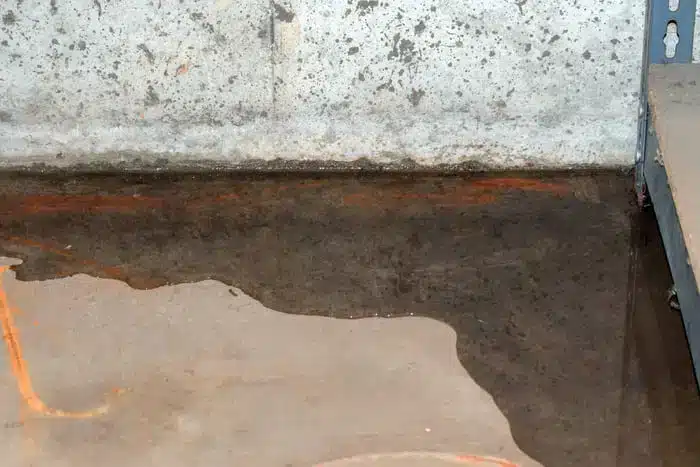Water in your basement does not just cause wet floors and damaged belongings. Every minute that water sits there, means potential damage to your home’s foundation, walls, and even the air quality upstairs. The most surprising part is that the issue is not always where the water appears. That mysterious puddle could mean a cracked foundation, poor drainage, or even landscaping issues twenty feet away from your house. Smart homeowners know the truth; catching water problems early saves thousands in repairs. In this blog, we’ll cover the most common causes of basement flooding, and how to get water out of the basement, helping you protect your property and peace of mind.
Why is Your Basement Wet?
Water can sneak in through cracks in your foundation walls, seep up through the floor, or even form from moisture in the air, causing water damage in your basement. Any homeowner who spots water stains feels dampness on the walls or smells a musty odor has likely discovered the start of a water issue. If you don’t address moisture issues in your basement quickly, they can cause serious damage to your home and create an environment that supports mold growth.
Understanding What Causes a Wet Basement
Learning how to fix a wet basement starts with understanding the causes of water damage. That being said, a wet basement can be caused by a number of things, including the following:
Hydrostatic Pressure
Soil surrounding your foundation acts like a massive water reservoir, storing moisture that creates pressure that pushes against your basement walls. This pressure builds gradually, forcing water through concrete pores and hairline cracks in the foundation and basement floor. Professional drainage systems work as strategic barriers, redirecting water before it can breach your basement’s defenses.
Poor Drainage Systems
Drainage systems are your home’s water management network, and when they fail, basements become prime targets for moisture invasion. Blocked pipes, clogged drain tile, and soil erosion create direct pathways for water to travel toward your foundation. Roots can infiltrate your foundation or drainage systems, causing cracks or unexpected blockages that redirect water flow. These compromised systems transform your property’s perimeter into a potential water collection zone. Professional assessments can pinpoint exact drainage vulnerabilities before they escalate into significant moisture problems.
Cracks in the Foundation
Concrete foundations aren’t indestructible; they develop cracks from ground movement, temperature fluctuations, and natural settling processes. These cracks become entrance points for water, allowing moisture to seep through during rainfall or high groundwater periods. Horizontal cracks, or stair-step cracks, indicate more serious structural issues than vertical hairline fractures. Newer and older homes alike can experience foundation cracking due to soil movement and environmental stress, and this will require foundation crack repair.
Plumbing Leaks
Internal plumbing creates another moisture entry point that often goes unnoticed until significant damage occurs. Pipes can slowly leak, creating a damp environment. Copper pipes are prone to condensation in humid basement areas, while older homes may have pipes that are leaking or wearing out due to age. Water heaters, washing machines, and utility sink areas are common leak locations. Temperature variations between the pipes and surrounding air can create condensation that mimics an active leak.
Sump Pump Failure
Sump pumps are your basement’s emergency water removal system, and their failure can trigger rapid flooding. Mechanical breakdowns, power interruptions, or unexpected blockages can render these critical devices useless. Sump pumps can stop working due to motor burnout, switch problems, or blockages in the discharge pipe. Backup power sources and consistent maintenance are the best protection strategies against pump failure. By understanding your sump pump’s potential weak points, you can prevent unexpected water intrusion.
Groundwater Levels
Groundwater behaves like an underground river, constantly testing your basement’s resilience. Local geological conditions, seasonal rainfall patterns, and water table fluctuations create increased moisture challenges. Properties built in low-lying areas or with inadequate landscape grading are more susceptible to groundwater-related basement moisture issues. Water naturally seeks lower ground, and without proper management, it will find its way into your basement. Waterproofing professionals can map out comprehensive water management strategies according to your specific property characteristics, preventing water leaks and damage.
5 Ways To Get Water Out of Your Basement
Basement water damage can destroy your home’s foundation, promote mold growth, and ruin valuable possessions in hours. Unchecked moisture rapidly deteriorates your home’s structural integrity and poses serious health risks. Here are several targeted methods to keep your basement dry:
Use a Wet/Dry Vacuum
Wet/dry vacuums, also known as shop vacuums, are one of the best water removal tools. These machines work differently from standard vacuums, featuring robust suction designed to handle both liquids and solid debris. Target carpeted areas by pressing down the nozzle firmly, ensuring maximum water removal with each pass. Move systematically across wet surfaces, paying extra attention to corners.
Improve Air Circulation
Moisture appears in stagnant basement environments, making air movement critical. Position fans strategically to create cross-ventilation, pushing damp air out and bringing fresh air in. Dehumidifiers work silently, pulling water particles from the air and preventing potential mold growth. Run these devices consistently, especially in areas with high humidity or recent water exposure. Focus on creating a consistent airflow that discourages moisture buildup.
Check and Clear Gutters and Downspouts
Gutters directly impact your basement’s moisture levels by controlling water flow around your home’s foundation. Conduct thorough inspections twice yearly, removing leaves, twigs, and debris that block water drainage. Ensure downspouts extend at least 4-6 feet from your home’s base, creating a clear path for water to be directed away from the foundation.
Install a Sump Pump
Sump pumps automatically activate when water levels rise, quickly pumping water away from your foundation. Choose battery-operated models to ensure continuous protection, even during power failures. Position the pump at the basement’s lowest point for maximum water removal efficiency. Conduct regular maintenance to guarantee reliable performance during critical moments.
Contact Professionals
Some water damage challenges require calling in waterproofing professionals. Water damage restoration professionals conduct full-scale investigations into your moisture problems through water removal, deep cleaning, and sanitization services. Armed with industrial-grade equipment, they diagnose and eliminate water damage. It’s important to look for waterproofers who offer detailed moisture mapping and long-term prevention strategies. Their expertise will be invaluable for sudden or persistent basement water problems and restore your basement to pristine condition.
Protect Your Basement
At Bluebird CFW Foundation Repair & Waterproofing, we meet your basement challenges with simple solutions. Our basement waterproofing solutions provide protection for your home, safety for your family, and expert help. We’ll protect your home’s foundation and help keep your basement dry. Call us today for a FREE inspection.





